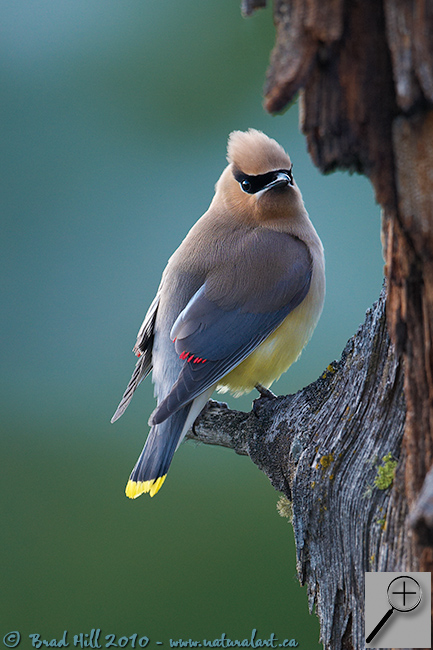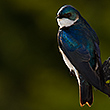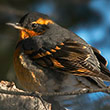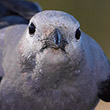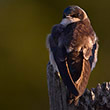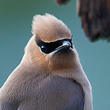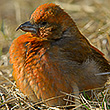Availability: Undetermined - Enquiries?
In the Field
Cedar On Pine. Findlay Creek, BC, Canada. June 8, 2010.
Simply a Cedar Waxwing on a long-dead Ponderosa Pine snag. I captured this image in early June of 2010 after returning from my annual "Grizzlies of the Khutzeymateen" Instructional Photo Tour. During the grizzly photo tour I used my 400mm f2.8 VR lens a lot, including with a 1.4x teleconverter, which turns it into an "almost" 600mm lens (550mm actually). I was able to capture some really nice shots with the "550mm" and began to wonder if it was worth keeping my 600mm VR lens. First day back in the field back home I went out before sunrise with my "real" 600mm lens and promptly captured this image. When I returned to my cabin and processed the image I made up my mind - I'm keeping the 600!
Why? I've found that with care (stopping down a little and being very careful with the focus) it's possible to render your subject very sharply with Nikon's 1.4x TC-14EII teleconverter or with the newer 2x TC-20EIII teleconverter (I'm NOT a fan of the 1.7x TC, but that's another story). But (and to me this is a pretty big BUT), for some reason I can't explain, the teleconverters seem to noticeably reduce the smoothness and visual quality of the out-of-focus zones (which is often referred to as "bokeh"). Notice the silky (and almost buttery) smoothness of the background in this image - in my opinion it's a huge reason why I like the image. This background is NOT digitally blurred in post-processing - it's exactly what the LENS produced (or, if you're a cynic, what the lens "manipulated" in the scene - think about that one!). If I shot this image with my "550mm" (400 plus 1.4x TC) there would be slightly more "nervousness" and less smoothness in the background. Teleconverters DO have their place, and many images don't need a soft, smooth background to be successful. But there are times when mimicking a longer telephoto with a teleconverter and shorter lens just doesn't cut it...
One last comment about this image. I shot this image before the sun had cleared the mountain peaks directly behind the subject. But, even without the sun being out, there was a directional component to the lighting and the bird was backlit. It was the kind of shot (as seen through the viewfinder) where it would have been easy to miss the rim lighting and blow out the highlights. Fortunately, I noticed the highlights, backed off my exposure a little, and then retrieved the necessary shadow detail in post-processing. So it pays to watch for the highlights associated with directional lighting, even when that sun isn't out!
Behind the Camera
Cedar On Pine. Findlay Creek, BC, Canada. June 8, 2010.
Digital Capture; RAW 14-bit format; ISO 1250.
Nikon D3s with Nikkor 600mm f4 VR lens supported on Gitzo 1348 tripod with Wimberley head. VR on and set to "Normal" mode.
1/200s @ f5; -0.33 stop compensation from matrix-metered exposure setting of camera.
At the Computer
Cedar On Pine. Findlay Creek, BC, Canada. June 8, 2010.
RAW Conversion to 16-bit TIFF, including first-pass/capture sharpening using Phase One's Capture One Pro 5. Two RAW conversions at different exposure settings. Exposure settings of -0.8 stops (to reduce brightness of highlights on rim of bird and to darken background); -0.2 stops for the remainder of the bird.
Further digital corrections on 16-bit TIFF file using Adobe's Photoshop CS5 and Light Craft's LightZone. Photoshop adjustments included compositing and masking of 2 exposure versions, selective brighening of portions of the bird (using a brightness adjustment layer plus masks), selective saturation and desaturation of colours, and selective sharpening for web output. Final tonemapping and tweaking performed with LightZone use the (tonemapper/re-light tool). No noise reduction in post-processing (aside from "automatic" noise reduction during RAW conversion).
Conservation
Cedar On Pine. Findlay Creek, BC, Canada. June 8, 2010.
Ten percent of the revenue generated by this image will be donated to Wildsight.
Species Status in Canada*: This species is not designated as at risk.
The Cedar Waxwing (Bombycilla cedrorum) is a neotropical migrant that is named for the red wax-like tips of their secondary flight feathers. These highly gregarious birds can be found in very large flocks in the non-breeding season, and during the breedings season they may even nest in loose colonies. Cedar Waxwings vary from common to uncommon in their preferred habitat, which includes woodland, forest edge and farmlands with fruit trees.
This Cedar Waxwing was photographed in the Columbia Valley of the East Kootenays. Many ecosystems within the Columbia Valley face development pressure, including pressure from logging operations. While Cedar Waxwings are not directly threatened in the Columbia Valley, they do, of course, need appropriate habitat in order to continue to thrive. Wildsight is an effective conservation organization that protects biodiversity and promotes sustainable communities in Canada's Columbia and Rocky Mountains. Support for Wildsight, through donation or becoming a member, will help ensure that they remain effective in their efforts to conserve threatened or endangered species and ecosystems.
*as determined by COSEWIC: The Committee on the Status of Endangered Wildlife in Canada













